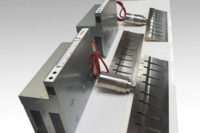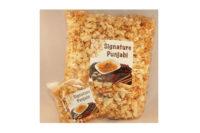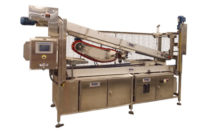New mixing technology enables bakers to create more and superior products, while addressing costs, labor, sanitation and other production issues.
Whether they specialize in breads and rolls or cookies and pastries, most bakers are looking for ways to increase output, reduce costs and improve sanitation. Today’s mixing systems enable them to address these issues and others at the onset of production.
“Safety and sanitation are very important with all mixer applications,” says Bruce Campbell, vice president of global product technology, AMF Bakery Systems, Richmond, VA, a Markel Bakery Group company. “Of course, [mixer] durability and flexibility also are mandatory.”
AMF offers bakers a variety of mixing equipment solutions, all of which are constructed of stainless-steel for “the most sanitary dough handling environment,” he says.
Introduced at IBIE 2013, the company’s Open Frame Mixer (OFM-1600) offers small to large mixing capacity for bread, bun, roll, English muffin, tortilla, specialty and frozen dough. Its stainless-steel frame is made of round tubing for maximum sanitization, and has no moving parts
In October, AMF is partnering with Reading Bakery Systems, Robesonia, PA, another Markel Bakery Group company, to introduce Reading’s experience with Exact continuing mixing systems for pretzel, snack, cookie and pizza dough production to AMF bread and bun customers.
According to Campbell, continuous mixing reduces labor, improves consistency and temperature control, and increases water percentage. It also offers a simple process of metering liquid and dry ingredients at precise rates. “Continuous mixing technology has been validated on AMF Bun Systems for McDonald’s type buns at Northeast Foods,” he says. “A new line will be installed in late 2014.”
Other recent mixer improvements by AMF are the Y-T agitator for enhanced mixing; a maximum strength, minimum deflection bowl design; and the Dough Guardian Monitoring System, which enables consistent dough production within the parameters established for individual products.
Clean and fast
Terry Bartsch, vice president of sales, at Shaffer—a Bundy Baking company, agrees that there’s a lot of interest by bakers in sanitation, but not just due to increased government regulations or consumer awareness. “Sanitation is also important as it relates to the ease and speed of changeovers,” he says. “Having the ability to more quickly and easily changeover allows bakers to run more products and have a more diverse product offering.”
The Urbana, OH, company offers horizontal mixers with three different agitators (roller, Sigma arm and double Sigma arm) as well as three different frame designs (traditional enclosed, open and hybrid). The hybrid mixer—the company’s latest design—incorporates the best features of a traditional enclosed frame mixer (watertight enclosures) and the open-frame design which result in sanitation savings has a direct-drive system, according to Bartsch.
“Our open-frame and hybrid-frame mixers prove to take less time for sanitation procedures because the area under and around the mixer is open and can be easily cleaned,” Bartsch explains. “In the case of the hybrid-frame mixer, the hydraulic system is also completely enclosed in a watertight enclosure, which allows for easy spraydown. We also provide bowl seals that can be easily removed and have self-retaining hardware for easy installation.”
Bartsch says Shaffer also customizes mixers to provide simple and ergonomically safe options to more easily load ingredients that can’t be incorporated through automatic ingredient feed systems.
To address product diversity, the company offers mixers with a two-way tilt system or manual ingredient doors in the canopy.
Demand for clean-in-place
Bob Peck, vice president of engineering at E.T. Oakes Corp., a Hauppauge, NY-based manufacturer of continuous and slurry mixers, depositors and blenders, says he’s seeing a trend toward clean-in-place (CIP) machines due to sanitation concerns. “Two or three bigger companies recently wanted that,” he says. “We offer our machines as CIP-ready, meaning we’ll put a CIP pump on our skids with our machines, so if and when [customers] want to use CIP, they’ll be ready to go. We make our base plates a little bit bigger to make provisions for [the pump], which we sometimes supply.”
The company also recently made several changes to its slurry mixers that facilitate cleaning. It changed the scrapers from a single-blade type to a multiple finger-type, which Peck says better follows the contour of the tank, and more effectively scrapes cake batter from the side of the tank.
E.T. Oaks also added spray balls to the bottom of its mixer and tank covers. “The spray balls are another thing that help with CIP and cleaning out the mixer,” Peck explains. “They’re pretty standard for industry.”
Another improvement that the company made to its slurry mixers was changing the shaft seal design from a V-ring seal, which required occasional maintenance and adjustments to a cinch seal (air bladder), which requires no maintenance. “That was a pretty big improvement,” Peck notes, adding that E.T. Oaks’ mixers now come with only electric motors.
The need for speed
While sanitation is a top concern for bakers and snack producers when selecting a mixing system, production speeds and rates are important, too.
“We made equipment that has a little bit higher capacity to meet that demand,” explains Peck. “We’ve been doing this for a while.”
Claire Auffredou, marketing manager at VMI, Montaigu, France, adds automation to the list. “We are seeing higher requirements toward the level of [automation] to ease maintenance, reduce manual operations on the line and, of course, increase productivity,” she says. “Flexibility and easy product changeover are [also] key factors, as bakers are seeking new markets and thus expanding the range of bread types and bakery products they offer.”
VMI manufacturers a broad range of mixers that create artisan and industrial bakery and pastry products. The company launched two additional innovations earlier this year at Europain and Interpack: Continuum, a continuous vacuum mixer designed to meet the specific issues of the loaves, buns and soft dough industry (milk bread, brioche and so on); and the Kneadster, a spiral mixer that reduces mixing time while reducing dough temperature.
Auffredou adds that food safety and traceability are obviously more relevant to customers today. “We try to support them in these issues through our monitoring supervisions and HMI (human machine interface),” she says, adding that the company’s spiral mixers address customers’ need for flexibility. The mixers can whip, aerate fill and knead; come with a variety of tools and bowl sizes; and allow for quick recipe changes.
VMI’s Verymix and Continuum continuous mixers, meanwhile, also have two features that make them versatile: They’re designed to be easy to clean between different product runs; and are equipped with supervision systems that allow users to quickly program new recipes.
Rapidojet, a hydration and mixing system available from Bakery Concepts International LLC, Enola, PA, helps bakers to reduce production time, labor, ingredient costs and sanitation issues, while increasing total yield and product shelf life, says Ken Schwenger, president.
Rapidojet can be used to pre-hydrate minors, such as bran, whole wheat, vital wheat gluten, flour for sponge and more, before bakers add them to a traditional final mixer. This enables bakers to reduce mixing time, yeast and conditioner levels and the amount of minors needed. The system can also be used to pre-hydrate 100% of the flour added to a traditional mixer, thus reducing mixing time and yeast and conditioner levels. In addition, it can be used as a continuous mixer for batters and dough, eliminating the need for vertical mixers, removable bowls and hoists with batter production and delivering dough directly to the divider with continuous dough production.
Bakery Concepts offers three Rapidojet models: RJ 5000; RJ 3500; and RJ 700, the newest model. Each number corresponds to the hourly output in kilograms at 100% hydration. Most importantly, says Schwenger, Rapidojet is capable of fully hydrating a wide range of dry ingredients, from about 20-350%, depending on the dry ingredients being hydrated.
“With the addition of the RJ 700, the needs of the midsize, wholesale baker can easily be addressed,” Schwenger adds. “This machine is very small and energy-efficient.”
Specialty products, special mixing needs
Consumer demand for gluten-free, allergen-free, whole-grain, clean-label and other better-for-you baked goods and snacks is also impacting bakers’ and snack producers’ mixing equipment requirements.
“Rising consumer demand for specialty products, especially those products such as gluten-free and allergen-free, where there are direct health implications associated with the products, promotes an increased need for mixer designs that are easily and quickly cleaned to assure allergens are not present in these specialty products,” says Campbell, adding that AMF Bakery Systems has integrated open-frame, agitator, seal and scraper designs and ample bowl access into its new mixer designs to address these issues.
“With allergens, ensuring the equipment is completely sanitized is imperative,” agrees Bartsch. Shaffer’s frame designs and bowl seal design, therefore, allow for quicker and more thorough mixer sanitation.
Dough for gluten-free products, Bartsch says, can be very different from its standard counterparts. “We recently sold a Sigma arm mixer for a gluten-free pizza dough application,” he explains. “Traditionally, a pizza dough is mixed on a roller bar mixer, but because the ingredients and dough characteristics varied significantly from standard pizza dough, we determined that a Sigma arm would actually work and develop the dough more properly.”
Schwenger confirms that whole grains are also playing a bigger role in commercial bakeries. He reiterates that the Rapidojet easily and quickly increases the hydration level of whole grains and eliminates soaking time, while substantially improving total yield and product shelf life.
Purchasing pointers
As when purchasing any equipment, bakers and snack producers may want to talk with colleagues about the pros and cons of their mixers and with mixing equipment manufacturers before investing in a new mixer.
Shaffer’s Bartsch says it’s important for bakers to consider the entire mixing operation. He recommends they asked such questions as how will ingredients be fed into the mixer? What is the dough dumping into or onto? Have they significantly reformulated a dough or made other changes that could affect the required mixing action?
“We take a holistic approach to mixer design and custom-build each mixer to meet customer needs,” he says. “Whether they have height constraints or need a 140-deg. tilt and a custom frame design to discharge onto a lay-time conveyor, our goal is to provide an intelligent design that is a real mixing solution for our customers.”
Auffredou also says that bakers and snack producers should consider a mixer as part of a line and as a long-term investment. She suggests they ask themselves: How long it will take to leverage their operational investment and see competitive advantages? What gains they will achieve in terms of quality and new market opportunities? What type of maintenance will the mixing system require and will the manufacturer be responsive to their service needs, now and in the future?
To that end, bakers and snack producers may also want to check out the availability of replacement parts before investing in a new mixing system. “When customers buy a machine, they want us to recommend at least one or two years’ worth of spare parts that they feel they would need,” says E.T. Oakes’ Peck. “I’m seeing a trend toward that.”
Meanwhile, Christine Banaszek, application engineer at Hauppauge, NY-based Charles Ross & Son Co. recommends equipment testing whenever practical. “We assist customers during mixing selection in performing simulation trials utilizing their own raw materials,” she says. “Customers visit our testing and development center for a proof-of-concept demonstration and/or rent a mixer to run unlimited mixing trials at their own facility. Through actual testing, bakers and snack producers can identify specific features that they need in their new mixer or blender and that would benefit their particular application.”
Motor horsepower, agitator design and speed, blending time, optimal working volume, discharge valve design, multiple recipe handling capability and vacuum versus atmospheric operation are just some of the features typically confirmed during testing, Banaszek says, adding that mixer controls are also another important consideration.
Campbell also cites computer controls for monitoring dough development, cooling abilities and recipe-management systems for ensuring repeatability as factors bakers and snack producers should take into consideration when purchasing a mixing system.
Bowl durability and layout flexibility are on Campbell’s list, too. “The more flexible the layout, the more useful the investment will be as production demands change over the years,” he explains, adding that customers should also ask equipment suppliers about the bowl’s design, batch capacities, absorption rate and replacing components.
“AMF ensures that we ask all the right questions before a mixer solution is quoted,” Campbell sums ups. “Since we have a long list of successful installations around the globe for many different mixing solutions, we know the right questions to ask and the right solutions.”














